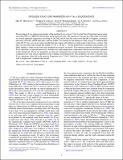| dc.contributor.author | Mitschang, Arik W. | |
| dc.contributor.author | Schulz, Norbert S. | |
| dc.contributor.author | Huenemoerder, David P. | |
| dc.contributor.author | Nichols, Joy S. | |
| dc.contributor.author | Testa, Paola | |
| dc.contributor.author | Huenemoerder, David P. | |
| dc.date.accessioned | 2015-02-27T16:52:25Z | |
| dc.date.available | 2015-02-27T16:52:25Z | |
| dc.date.issued | 2011-06 | |
| dc.date.submitted | 2010-09 | |
| dc.identifier.issn | 0004-637X | |
| dc.identifier.issn | 1538-4357 | |
| dc.identifier.uri | http://hdl.handle.net/1721.1/95734 | |
| dc.description.abstract | We investigate X-ray emission properties of the peculiar X-ray source θ[superscript 2] Ori A in the Orion Trapezium region using more than 500 ks of HETGS spectral data in the quiescent state. The amount of exposure provides tight constraints on several important diagnostics involving O, Ne, Mg, and Si line flux ratios from He-like ion triplets, resonance line ratios of the H- and He-like lines, and line widths. Accounting for the influence of the strong UV radiation field of the O9.5V star, we can now place the He-like line origin well within two stellar radii of the O-star's surface. The lines are resolved with average line widths of 341 ± 38 km s[superscript –1]. In the framework of standard wind models, this likely implies a rather weak wind with moderate post-shock velocities. The emission measure distribution of the X-ray spectrum, as reported previously, includes very high temperature components which are not easily explained in this framework. The X-ray properties are also not consistent with coronal emissions from an unseen low-mass companion nor with typical signatures from colliding wind interactions. The properties are more consistent with X-ray signatures observed in the massive Trapezium star θ[superscript 1] Ori C which has recently been successfully modeled with a magnetically confined wind model. | en_US |
| dc.description.sponsorship | United States. National Aeronautics and Space Administration (SAO, under NASA contract NAS 8-03060) | en_US |
| dc.description.sponsorship | Smithsonian Astrophysical Observatory (SAO contract NAS 8-03060) | en_US |
| dc.description.sponsorship | Smithsonian Astrophysical Observatory (SAO contract SV3-73016) | en_US |
| dc.language.iso | en_US | |
| dc.publisher | Institute of Physics/American Astronomical Society | en_US |
| dc.relation.isversionof | http://dx.doi.org/10.1088/0004-637x/734/1/14 | en_US |
| dc.rights | Article is made available in accordance with the publisher's policy and may be subject to US copyright law. Please refer to the publisher's site for terms of use. | en_US |
| dc.source | American Astronomical Society | en_US |
| dc.title | DETAILED X-RAY LINE PROPERTIES OF θ[superscript 2] Ori A IN QUIESCENCE | en_US |
| dc.title.alternative | DETAILED X-RAY LINE PROPERTIES OF θ2 Ori A IN QUIESCENCE | en_US |
| dc.type | Article | en_US |
| dc.identifier.citation | Mitschang, Arik W., Norbert S. Schulz, David P. Huenemoerder, Joy S. Nichols, and Paola Testa. “ DETAILED X-RAY LINE PROPERTIES OF θ[superscript 2] Ori A IN QUIESCENCE .” The Astrophysical Journal 734, no. 1 (May 20, 2011): 14. © 2011 American Astronomical Society. | en_US |
| dc.contributor.department | MIT Kavli Institute for Astrophysics and Space Research | en_US |
| dc.contributor.mitauthor | Schulz, Norbert S. | en_US |
| dc.contributor.mitauthor | Huenemoerder, David P. | en_US |
| dc.relation.journal | Astrophysical Journal | en_US |
| dc.eprint.version | Final published version | en_US |
| dc.type.uri | http://purl.org/eprint/type/JournalArticle | en_US |
| eprint.status | http://purl.org/eprint/status/PeerReviewed | en_US |
| dspace.orderedauthors | Mitschang, Arik W.; Schulz, Norbert S.; Huenemoerder, David P.; Nichols, Joy S.; Testa, Paola | en_US |
| mit.license | PUBLISHER_POLICY | en_US |
| mit.metadata.status | Complete | |
